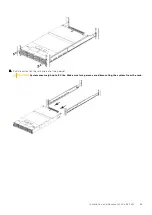
Verify the DD6300 system
About this task
When the system first boots after replacing the chassis, it displays a menu that prompts for permission to perform a headswap.
CAUTION:
If a headswap is not performed, the system will not boot.
Steps
1. When prompted, allow the system to perform a headswap.
2. If configuration details were captured before the procedure (see
Preliminary and troubleshooting steps
on page 53), confirm
that the new system configuration is complete and accurate.
3. Run the
disk rescan
command to discover the disks.
a. If all of the disks are not listed, perform another rescan.
b. If all of the disks are still not listed, reboot the system.
4. Check the disk status by entering:
#
disk show state
Enclosure Disk
1 2 3 4 5 6 7 8 9 10 11 12 13 14 15
--------- ----------------------------------------------
1 . . . . s . . s s s s s v v
2 s O O O O O O O O O O O O O O
3 O O O O O O O O O O O O O O s
--------- ----------------------------------------------
Legend State Count
------ ------------- -----
. In Use Disks 6
s Spare Disks 8
v Available Disks 2
O Foreign Disks 28
------ ------------- -----
Total 44 disks
The output should indicate:
●
The correct disks are seen.
●
The data storage is not configured.
●
The data storage is foreign storage and that there is a complete set of foreign storage available.
5. Verify the health of the file system by entering these two commands:
#
filesys status
NOTE:
If the output of this command shows that the filesystem is down, attempt to enable the filesystem using the
filesys enable
command before entering the
filesys show space
command.
#
filesys show space
6. If the host name of the system changes after the headswap procedure, modify the following as applicable:
a. For systems using CIFS: Re-join the CIFS domain by issuing the command:
#
cifs set authentication active-directory
domainname
b. For systems with the Replication feature: Use the
replication modify
commands to update the hostname.
7. If needed, verify the functionality of the I/O modules. For specific information, refer to the
Data Domain DD6300, DD6800,
and DD9300 Field Replacement Unit Guide
.
8.
NOTE:
The user information is retained in the management module registries and IPMI user IDs are in the BMC. You
might have to work with the customer to get the new MAC addresses on the network.
58
Field Replaceable Units




















